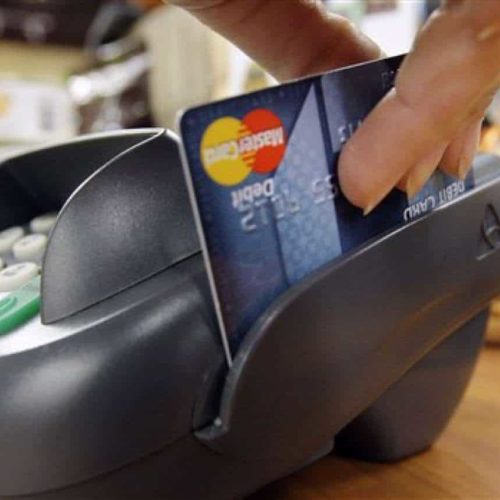Introduction
Competition usually pushes prices lower.
But in the case of debit card processing fees, aggressive competition between Visa and MasterCard to win banks’ business has helped keep swipe fees high and resulted in an annual $16 billion bonanza for U.S. banks.
This little-noticed aspect of debit processing fees has been lost in the lobbying brawl under way as banks try to delay or kill a cap on the fees included in the sweeping Dodd-Frank financial reform law last summer. Congress left it up to the Federal Reserve to work out the details, and the Fed proposed a ceiling of 12 cents to process each debit transaction — a sharp cut from the current average of around 44 cents per transaction.
Why should consumers care? Debit cards are now the most popular payment mechanism used by American shoppers, accounting for half of all transactions. And each time a shopper swipes a card to buy a quick latte or to invest in a pricey DVD player, his or her bank earns a fee from the retailer. On the sale of a $100 television, for instance, the retailer may get $98 while the bank gets most of the rest.
Retailers welcome the Fed’s proposed cap, saying debit processing fees have forced them to raise prices. Consumer advocates say these higher prices are being borne by all customers, whether they pay with plastic or not. And banks say a cut in fees means they may have to make up the revenue by taking away free checking accounts and other services.
While both banks and retailers play starring roles in the unfolding regulatory drama, neither sets the actual processing fees. That’s up to companies such as Visa Inc. and MasterCard Inc., which dominate the card payments industry.
The fees that banks charge retailers for debit transactions have shot up in the past decade. Banks now collect an average 23 cents from every debit card PIN transaction, for example, up from just 7 cents a decade ago, according to Federal Reserve economists.
Critics, including dozens of large merchants who are suing Visa and MasterCard, say the underlying competition between the two card companies helped drive up fees over the years, in part because their business interests are more aligned with banks than with retailers.
“This system is so buried and has been so esoteric that nobody has paid attention to it,” said Thomas Undlin, lead attorney in a merchants’ class action lawsuit accusing Visa and MasterCard of anti-competitive behavior.
Whether a customer’s bank is JPMorgan Chase or Bank of America, swipe fees the merchants pay to a specific card company are the same. All the banks that issue Visa cards get the Visa fee schedule, and all the banks that issue MasterCards get the MasterCard fee schedule. Undlin’s clients argue that amounts to price-fixing by the card companies.
Similar lawsuits have been filed by retailers such as Kroger Co., Rite Aid Corp. andPayless ShoeSource, Inc. Over the past decade, the Justice Departmentand mega-merchants like Wal-Mart have won concessions on grounds that Visa and MasterCard’s behavior has been anti-competitive. Most recently, Visa and MasterCard agreed in an October 2010 settlement with the government to stop prohibiting merchants from offering discounts to customers who use a card that carries lower interchange fees which can save the retailer money.
Visa and MasterCard did not respond to iWatchNews requests for comment.
But in the past, the companies have said they can’t be monopolistic because consumers have so many other ways of paying. When the antitrust lawsuit was initially filed in 2005, Visa argued that cash, credit and checks were available as alternative payment methods for consumers. The case has been tied up in pre-trial motions ever since.
The Electronic Payments Coalition, an industry group representing Visa, MasterCard, several big banks, and a number of state banking groups, says complaining merchants forget that the popularity of debit cards has spurred more sales for them.
“You have to be able to balance on one side being able to charge a small enough amount so that retailers will accept the cards, and on the other side offer enough revenue so that banks will be willing to issue those cards,” said Trish Wexler, spokeswoman for the Electronic Payments Coalition.
The debit processing fee helps pay for the electronic network that authorizes, clears and settles each purchase. It also helps defray the costs of fraud, fraud prevention, data security, customer assistance and disputes, and producing debit cards, according to banks.
Ads, websites, letters
With billions of dollars at stake, banks and merchants have mounted a major lobbying battle.
Advertisements on the Washington, D.C., subway system paid for by banks announce that “Washington is helping giant retailers clean out your wallet.” Hundreds of banks and credit unions across the country have sent letters to the Fed and to their House and Senate lawmakers criticizing the proposed fee cap and warning of dire consequences should it be enacted.
The American Bankers Association said last week that the Fed’s proposed 70 percent cut in debit processing fees means banks will lose money on every transaction. “The only options left will be to shift these costs to consumers or cease providing debit cards,” said ABA President Frank Keating.
The bankers group also scoffed at the notion that consumers would benefit from a cap on the fees, saying there was no assurance that retailers would pass along any savings to shoppers. The fee cap, according to bankers, amounts to price fixing by the government.
Retailers have fought back. The Merchants Payments Coalition launched the website www.unfaircreditcardfees.com, which is attacking interchange fees for both debit and credit cards. It says, for example, card companies and banks are collecting as much as 8 cents in processing fees for each gallon of gasoline bought by consumers.
Merchants also have a powerful supporter — Dick Durbin, the No. 2 Democrat in the U.S. Senate who authored the Dodd-Frank amendment requiring a cap on debit swipe fees. After JPMorgan Chase CEO Jamie Dimon criticized the debit fee at length in his annual letter to shareholders, Durbin responded with a letter of his own.
The proposed cap will “rein in the fee collusion that your bank and thousands of other banks currently engage in through Visa and MasterCard,” Durbin said in an April 12 letter to Dimon. “I recognize that Chase will likely see decreased revenue from interchange reform, but I urge you to keep some perspective. Last year Chase had $17.4 billion in profits — up 48 percent from the previous year — and a 15 percent profit margin … In contrast, middle-class American families are struggling to get by in a tough economy — an economy that went south because of the banking industry’s unregulated excesses.”
Durbin is not the only one using the word “collusion” when describing the role of Visa and MasterCard in setting the so-called interchange fee. The question of whether Visa and MasterCard set anti-competitive fees is at issue in a pair of long-running, multibillion-dollar class-action lawsuits filed by retailers.
Where the money comes from
To understand what all the fuss is about, it helps to know a little about how the swipe fee works.
Visa and MasterCard are not the only card networks, but they are the biggest. In 2007, they together controlled 77 percent of all debit transactions, according to a 2009 paper written by four Fed economists. (Other card networks like American Express and Discover handle fewer transactions and operate under a different model.)
Swipe fees have always been there, but paying with plastic has grown more popular in recent years. According to the Fed, debit card purchases now represent about half of all consumer purchases, while paper checks account for 30 percent of transactions. Shoppers used debit cards nearly 38 billion times in 2009, up dramatically from about 15 billion times in 2003. With that volume of the market, retailers say they have no choice but to accept debit cards.
In a 2001 trial of civil antitrust charges against Visa and MasterCard, merchants including Target and Saks Fifth Avenue testified “that if they were to stop accepting Visa and MasterCard general purpose cards they would lose significant sales.”
Since banks earn money from each card swipe, increasing card use has meant increasing costs for merchants. But it’s not just the incidence of card use that has gone up. The cost to merchants for each card swipe has grown, too.
Exactly how much it costs banks and the card companies to process a debit card purchase varies based on whether a consumer uses a PIN-based debit card or a signature-based debit card. Since 2000, many PIN debit cards have adopted a fee that is a percentage of the value of the transaction.
“PIN debit fees began to increase in the early 2000s, while signature debit fees declined in late 2003 and early 2004,” though that drop came after a settlement in litigation over signature fees, the Fed said after surveying both banks and retailers to prepare its proposed rule. “More recently, both PIN and signature debit fees have increased, although PIN debit fees have increased at a faster pace.”
Wexler of the Electronic Payments Coalition said the Fed’s analysis is flawed because it examined only the interchange fee for debit card transactions, as required by the Dodd-Frank law. An interchange fee is also imposed for processing credit card transactions. “If you look at the total interchange average,” Wexler said, “the average rate has stayed relatively constant.”
Card companies make money every time they process a transaction, but they depend on banks to issue cards to customers. In order to get more swipes, card companies need more banks using their processing networks. The way they entice the banks, Undlin said, is by offering higher and higher swipe fees.
“There is competition” between card companies, Undlin said, “but it’s a perverse competition.”
Until recently, Visa and MasterCard were private companies whose boards were dominated by representatives from banks issuing their cards. Visa grew out of Bank of America Corp. when it began issuing credit cards in 1966 and then gradually began licensing the processing network to other banks.
Both companies went public in the past five years and now have a majority of independent directors on their boards. Today, MasterCard’s board of directors includes senior executives from Citigroup and UniCredit Group, plus former executives at Goldman Sachs and Southern Bank Berhad. Visa’s board includes a former Goldman Sachs vice chairman.
Lawsuits, settlements
Over the last decade, Visa and MasterCard have made various concessions to governments and private plaintiffs, in addition to a settlement reached in October. The card companies’ behavior after one case is instructive.
In 2004, the U.S. Supreme Court upheld a ruling in favor of the Justice Department, which accused Visa and MasterCard of violating antitrust law by blocking member banks from also issuing American Express cards. The court decision ended that practice, making American Express a bigger competitor.
“In response, Visa and MasterCard appear to have increased interchange fees to prevent banks from defecting to American Express, which pays a higher interchange fee — about 2.25 percent — to its bank partners,” wrote James Lyon, vice president of the Minneapolis Federal Reserve, in a paper.
In another case, the two card companies reached a $3 billion settlement in 2003 with Wal-Mart and other plaintiffs. As part of the deal, Visa and Master Credit agreed to stop requiring retailers that accept their credit cards to also accept their debit cards.
And in 2008, MasterCard complied with a European Union ruling by lowering its cross-border interchange fees, while it pursued an appeal.
Amid all the lobbying pressure — and more than 11,000 public comment letters — the Fed missed its April 21 deadline to issue a final rule on the interchange fee cap. But the Fed also said it was “committed to completing the rulemaking” before July 21. Because of how the Dodd-Frank law was written, if the Fed doesn’t issue a final rule by that date, its proposal to cap the swipe fee at 12 cents will become law.
In the meantime, bank lobbyists are racing to build bipartisan support for a Senate bill that would effectively kill the swipe fee cap by delaying it for at least two years.
The bill, introduced by Democrat Jon Tester of Montana, is supported by about 55 senators, according to American Banker. Senate legislation needs 60 votes to overcome procedural objections and move to a floor vote. But time is running out with Congress scheduled to take two more holiday breaks before the end of July.
“I think this is an issue that probably Congress should not have waded into because it’s choosing between two business interests,” said Ed Mills, a Washington policy analyst with FBR Capital Markets. “There are no easy answers here.”
Read more in Inequality, Opportunity and Poverty
Inequality, Opportunity and Poverty
The investment industry threatens state retirement plans to help workers save
States wrestle with impending retirement crisis as pensions disappear
Inequality, Opportunity and Poverty
As IRS crusades against Americans hiding money offshore, Latin American tax cheats flock to U.S. banks
IRS event today on plan to force banks to report foreign nationals’ accounts






Join the conversation
Show Comments